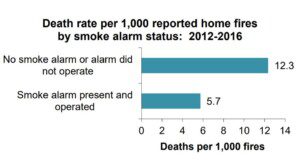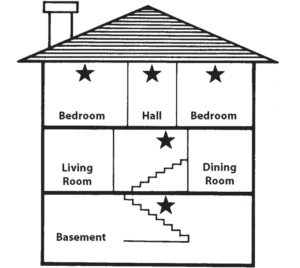Smoke Alarm Rules In Oregon:
Why We Need Alarms:
 Smoke alarms are a key part of a fire escape plan and are vital for the protection of home occupants in case of a fire. Smoke alarms serve as an early warning system that gives occupants a chance to escape the home. In 2016 there were 1,800 fatal residential house fires in the United States. According to the National Fire Protection Association, 3 out of 5 fire deaths between 2012 and 2016 were in homes without smoke alarms or in homes where the alarms failed to activate. Home occupants are 54% less likely to die in a house fire when the home has smoke alarms that activate when there is a fire.
Smoke alarms are a key part of a fire escape plan and are vital for the protection of home occupants in case of a fire. Smoke alarms serve as an early warning system that gives occupants a chance to escape the home. In 2016 there were 1,800 fatal residential house fires in the United States. According to the National Fire Protection Association, 3 out of 5 fire deaths between 2012 and 2016 were in homes without smoke alarms or in homes where the alarms failed to activate. Home occupants are 54% less likely to die in a house fire when the home has smoke alarms that activate when there is a fire.
Oregon’s Smoke Alarm History:
Smoke alarms became a requirement for Oregon homes in the 1970s. The requirements for locations and types of alarms have been updated since then to provide additional protection for the occupants of the home.
Minimum Smoke Alarm Requirements for Homes Being Sold:
At this time, when a home is listed for sale, Oregon requires that smoke alarms be installed in the following locations:
-
On each level of the home, including the basement.
-
Where sleeping areas are located on an upper level, the smoke alarm shall be installed as close as practical to the center of the ceiling directly over the stairway.
-
-
Outside sleeping areas, within the immediate vicinity of each bedroom or within 21 feet of the bedroom.
-
Where sleeping areas are widely separated and/ or where a single smoke alarm will not adequately service all sleeping areas, a smoke alarm shall be installed adjacent to each sleeping area.
-
Additional smoke alarm requirements go into effect based on the year the home was built or had a significant renovation. (See below for what constitutes a significant renovation.)
-
If the home was built or renovated on or after 1986, smoke alarms are required to be hardwired. This means that power has to be provided by the electrical wiring of the home. The power source cannot be a battery.
-
If the home was built or renovated on or after 1993, smoke alarms are required to be interconnected. This means that the alarms have to be connected in such a way that when one alarm sounds, they all sound.
-
If the home was built or renovated on or after 1996, smoke alarms are required in every bedroom.
Rules for New Construction Homes:
The following building code applies to new homes being built in Oregon:
ORSC 2017 R314.3:
“Smoke alarms shall be installed in the following locations:
-
In each sleeping room.
-
Outside each separate sleeping area in the immediate vicinity of the bedrooms.
-
On each additional story of the dwelling, including basements and habitable attics but not including crawl spaces and uninhabitable attics. In dwellings or dwelling units with split levels and without an intervening door between the adjacent levels, a smoke alarm installed on the upper level shall suffice for the adjacent lower level provided that the lower level is less than one full story below the upper level.
-
Smoke alarms shall be installed not less than 3 feet (914 mm) horizontally from the door or opening of a bathroom that contains a bathtub or shower unless this would prevent the placement of a smoke alarm required by Section R314.3.
-
In napping areas in a family home child care.”
Rules for Renovated Homes:
Oregon Building Code requires that any home that has had a significant renovation be updated to meet the same smoke alarm requirements as a new home built at that time. Meaning that a home renovated in 1996 has to meet 1996 smoke alarm building code requirements and a home renovated in 2018, has to meet 2018 code.
ORSC 2017 R314.2.2
“Where alterations, repairs or additions requiring a permit occur, or where one or more sleeping rooms are added or created in existing dwellings, the individual dwelling unit shall be equipped with smoke alarms as required for new dwellings.”
EXCEPTIONS: |
1. Work involving the exterior surfaces of dwellings, such as the replacement of roofing or siding, the addition or replacement of windows or doors, or the addition of a porch or deck are exempt from the requirements of this section. |
2. Installation, alteration or repairs of plumbing, electrical or mechanical systems are exempt from the requirements of this section. |


